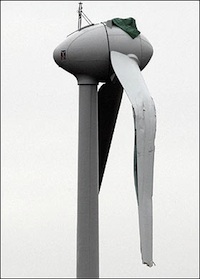Original URL: https://www.theregister.com/2011/08/03/windfarm_health_experts_awol/
Acoustic trauma: How wind farms make you sick
It's an ill wind ...
Posted in Science, 3rd August 2011 09:31 GMT
Industrial wind installations are creating a serious health issue, and comprehensive research is urgently needed, says a former Professor of Public Health.
"There has been no policy analysis that justifies imposing these effects on local residents. The attempts to deny the evidence cannot be seen as honest scientific disagreement, and represent either gross incompetence or intentional bias," writes Carl Phillips, formerly Professor of Public Health at University of Alberta, now an independent researcher.
"There is ample evidence that turbines cause a constellation of health problems, and attempts to deny this involve claims that are contrary to proper methods of scientific inference," Phillips writes in a paper published in the Bulletin of Science, Technology, and Society. It's one of several interesting papers in the journal, which is devoted to wind health issues.
Industrial wind installations produce audible and non-audible noise, and optical flicker. But campaigners are fragmented, and face a daunting alliance of big eco-business and government. The academic establishment, which is quick to leap upon public health issues, is strangely inert.
"There is a huge amount of evidence, and it's incredibly convincing," Phillips told us by phone, "but it takes a different form to what industry consultants present."

Empirical studies are rare. Renewable UK, the wind and wave industry lobby group, cites research by the Noise Working Group for the UK business department on its web page devoted to noise issues. The 1996 study, known as ETSU-R-97 (10-page PDF/1.8MB), recommended "Noise from the wind farm should be limited to 5dB(A) above background for both day-time and night-time", and in the Renewable UK portrait, wind farms sound idyllic; like nature, only more so.
"Outside the nearest houses, which are at least 300 metres away, and more often further, the sound of a wind turbine generating electricity is likely to be about the same level as noise from a flowing stream about 50-100 metres away or the noise of leaves rustling in a gentle breeze," the group writes.
Yet the ancient study, completed in 1996 and now so old it's actually in the national archive – has been heavily criticised. Sleep expert Dr Christopher Hanning has written:
"Its major flaws include the use of averaged noise levels over too long a time period and using a best fit curve, thus ignoring the louder transient noise of AM which causes awakenings and arousals. It ignores also the property of low frequency noise to be audible over greater distances than higher frequency noise. By concentrating on sound pressure alone, it ignores the increased annoyance of particular noises, especially that associated with AM. It is also the only guidance anywhere in the world which permits a higher sound level at night than during the day, completely contrary to common sense, noise pollution legislation and WHO guidelines."
[original emphasis]
Reality bites blows...
People living near wind farms – and near can be quite a long way away – find the reality far different to Renewable UK's pastoral idyll.
Dr Michael M Nissenbaum, a radiologist at Northern Maine Medical Center, has new work imminent on the study. He says "significant risk of adverse health effects is likely to occur in a significant subset of people out to at least 2,000 meters away from an industrial wind turbine installation. These health concerns include: sleep disturbance and psychological stress."
He continues: "Our current knowledge indicates that there are substantial health risks from the existing exposure, and we do not know how to reduce those risks other than by keeping turbines several kilometers away from homes."
Consultant Mike Stigwood, who has testified before public enquiries, points out that since ETSU-R-97 was published, the World Health Organization has twice lowered its recommended limits for night-time noise.
Currently there's no solution other than to site the wind turbines further away. But how far?
The Planning Policy Statement on Renewable Energy (PPS22) is often cited here, obliging local planning authorities to "ensure that renewable energy developments have been located and designed in such a way to minimise increases in ambient noise levels." It doesn't specify a distance, though.
Hanning notes that: "Proposals that site wind turbines within 1.5km of habitation will not keep wind turbine noise to an acceptable level and are therefore in contravention of PPS22."
Even at 2km, there are noticeable health consequences.
But there are signs the mood has shifted from one of acquiescence to Big Eco-business – with local authorities judging that they're accountable to the communities they're supposed to serve. In June, Highland Council temporarily shut down a 23-turbine installation in Sutherland after persistent complaints by residents. The operator, SSE, had failed to test noise levels at properties 2km away and failed to produce a noise mitigation plan. The stop notice has since been lifted. More are planned nearby. ®